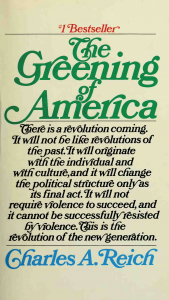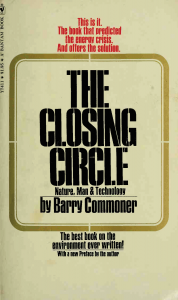Earth Day 1970
It is Wednesday, April 22nd. I remember another one, in 1970: a bright, warm, sunny day, not unusual for that time of year in Virginia Beach, Virginia, and a special day at Lynnhaven Elementary School. It was different – for one thing, we did not arrive in the usual school bus, but at our own leisure. I remember riding my bicycle, approaching the lively scene, the festive atmosphere, and the song that kept playing through my head, by the Fifth Dimension – Aquarius:
When the moon is in the Seventh House
And Jupiter aligns with Mars
Then peace will guide the planets
And love will steer the stars
This is the dawning of the Age of Aquarius…
It was Earth Day.
Was it that that song was playing in the background? Is that why it was stuck in my head? I don’t remember, nor do I remember much else of what happened that day, but I do remember the impression it left on me. The times, they were a-changin’. The Vietnam War was under way… fathers of two classmates were prisoners of war in the Hanoi Hilton; my own father was over there, where he would receive a Bronze Star with “V” for meritorious service in combat. The sexual revolution was in full swing, which I also knew from observing my friend’s older sister permanently ensconced on the living room couch, wrapped together intricately with her boyfriend – every time I went over, there they were – whilst an erstwhile role model in my neighborhood grew his hair long and kept begging another friend, who somehow had access, for condoms. I even remember – was it 1968? – my first sighting of a couple of hippies in bell-bottoms, in front of a local department store.
 On Earth Day I was 10 years old, in the fifth grade. By that time I had grown into quite the nature lover. I had dragged the family to a showing of Bambi at the Shore Drive-Inn Theater. I subscribed to Ranger Rick’s Nature Magazine, which had begun publication in 1967 (and is still being published). I compiled my own detailed notebook of the mammals of North America, complete with detailed drawings (copied from the popular Herbert S. Zim field guides – see graphic). I knew pretty much everything there was to know about animals, at least more than anyone else of my acquaintance. And I was an avid snake hunter, although it would be a few years before I became adept at it.
On Earth Day I was 10 years old, in the fifth grade. By that time I had grown into quite the nature lover. I had dragged the family to a showing of Bambi at the Shore Drive-Inn Theater. I subscribed to Ranger Rick’s Nature Magazine, which had begun publication in 1967 (and is still being published). I compiled my own detailed notebook of the mammals of North America, complete with detailed drawings (copied from the popular Herbert S. Zim field guides – see graphic). I knew pretty much everything there was to know about animals, at least more than anyone else of my acquaintance. And I was an avid snake hunter, although it would be a few years before I became adept at it.
I also remember some months later, the first day of the new school year. A new teacher for the sixth grade, whose name I cannot now recall; but I do recall his novel, hip look – brown tints, soft-soled shoes, collar-length hair. And his introductory “speech” in which he announced to the class that ecology was “his bag, his thing” – yes, I remember the words exactly.
Nature had become a big deal. This was also evidenced in the popular television prime-time broadcasts The Undersea World of Jacques Cousteau and Mutual of Omaha’s Wild Kingdom, both of which had unforgettable theme music, and both of which me and my family watched religiously.
 Charles Reich’s bestseller, The Greening of America, which came out in the fall of that year, captured the mood exactly, placing the burgeoning environmental movement within the context of all the other movements – anti-war, anti-establishment, the inimitable triad drugs/sex/rock-and-roll – which were making themselves felt at the same time. It was all of a piece, the harbinger of a new age.
Charles Reich’s bestseller, The Greening of America, which came out in the fall of that year, captured the mood exactly, placing the burgeoning environmental movement within the context of all the other movements – anti-war, anti-establishment, the inimitable triad drugs/sex/rock-and-roll – which were making themselves felt at the same time. It was all of a piece, the harbinger of a new age.
“There is a revolution coming,” wrote Reich, “not… like revolutions of the past. It will originate with the individual and with culture, and it will change the political structure only as its final act. It will not require violence to succeed, and it cannot be successfully resisted by violence. It is now spreading with amazing rapidity, and already our laws, institutions and social structure are changing in consequence. It promises a higher reason, a more human community, and a new and liberated individual. Its ultimate creation will be a new and enduring wholeness and beauty—a renewed relationship of man to himself, to other men, to society, to nature, and to the land.”
The younger generation – today we know them as the Boomers – was leading the way:
This is the revolution of the new generation. Their protest and rebellion, their culture, clothes, music, drugs, ways of thought, and liberated life-style are not a passing fad or a form of dissent and refusal, nor are they in any sense irrational. The whole emerging pattern, from ideals to campus demonstrations to beads and bell bottoms to the Woodstock Festival, makes sense and is part of a consistent philosophy. It is both necessary and inevitable, and in time it will include not only youth, but all people in America (p. 2).
For Reich, what this meant was the triumph of humanity, and nature, over technology. “Beyond the industrial era lies a new age of man. The essence of that age must be the end of the subjugation of man, the end of his subordination to the machine, and the beginning of the subjugation of the machine—the use of technology to create a still higher level of life, but one based upon values beyond the machine” (p. 386).
Reich did not reject the productive capacity of modern society, but rather celebrated it as the platform upon which the new revolutionary way of life could be built. “Since machines can produce enough food and shelter for all, why should not man end the antagonism derived from scarcity and base his society on love for his fellow man? If machines can take care of our material wants, why should not man develop the aesthetic and spiritual side of his nature? Prophets and philosophers have proposed these ways of life before, but only today’s technology has made them possible” (p. 383).
 However, Barry Commoner’s The Closing Circle, likewise published in the wake of Earth Day, upped the ante.
However, Barry Commoner’s The Closing Circle, likewise published in the wake of Earth Day, upped the ante.
Earth Day did have the advantage of opening many eyes. “The environment has just been rediscovered by the people who live in it,“ he wrote. “In the United States the event was celebrated in April 1970, during Earth Week. It was a sudden, noisy awakening. School children cleaned up rubbish; college students organized huge demonstrations; determined citizens recaptured the streets from the automobile, at least for a day. Everyone seemed to be aroused to the environmental danger and eager to do something about it” (p. 1).
All of a sudden, everyone was an environmentalist, but likewise everyone had an opinion on the matter, not all of which were helpful. “It seemed to me that the confusion of Earth Week was a sign that the situation was so complex and ambiguous that people could read into it whatever conclusion their own beliefs—about human nature, economics, and politics—suggested. Like a Rorschach ink blot, Earth Week mirrored personal convictions more than objective knowledge” (p. 7).
So Commoner took it upon himself to clarify the matter: pace Reich, it was precisely technology, the machine, and the production process built upon it, that was the problem. “The environmental crisis is somber evidence of an insidious fraud hidden in the vaunted productivity and wealth of modern, technology-based society. This wealth has been gained by rapid short-term exploitation of the environmental system, but it has blindly accumulated a debt to nature (in the form of environmental destruction in developed countries and of population pressure in developing ones)—a debt so large and so pervasive that in the next generation it may, if unpaid, wipe out most of the wealth it has gained us” (p. 294).
It is production that is the problem. Mankind must learn to live within the boundaries set by nature.
Fifty years have passed. Wednesday April 22nd is once again upon us; only this time it is the year 2020. The decade has changed, but the litany has remained the same. This goal, which is what the environmental movement would like to achieve, has now, fortuitously, been given a dry run in the Corona/Wuhan virus pandemic we are now experiencing, and environmentalists are making no bones about it.
We are told that this is nature’s response to our misuse and abuse of it. “‘Nature is sending us a message’, says UN environment chief.”
We are told, albeit in Dutch, that it is God’s response to robber capitalism.
We are told to celebrate the degree to which pollution has been reduced. Indeed, it is a wonderful thing the degree to which our carbon footprint and other nefarious effects on the environment have been cut back.
We are made to understand that it is capitalism that is responsible for the spread of the virus.
The flip side of this is 22,000,000 unemployed and counting in the US, while in Australia unemployment might hit 16%, with women and the young the worst hit. In the US, “non-essential” retailers (190,000 of which have already closed) have been devastated, while thirty million small businesses are threatened with temporary or permanent closure. In the UK, the news and entertainment industry is reeling. Best of all, the virus is destroying demand for crude oil. And it is putting the world on track for a new Great Depression.
The bottom line is, the cessation of activity and the shuttering of human life is exactly what the environmental movement has been after. Reduced production is music to its adherents’ ears.
But is not the economy itself an ecosystem? Is it not itself a fragile web of interconnected lives, a dizzying multiplicity of niches and niche-filling “organisms” known as firms, businesses, providers of goods and services, all competing with each other and supporting each other, engaging in ever-expanding, ever-complexifying, ever-mutating conjunctures of activity to feed, cloth, equip, entertain, inform the expanding global population of homo sapiens? As much as nature itself, the economy is the expression of what Joseph Schumpeter labeled “creative destruction.”
The drop in production, the job losses, the bankruptcies are not simply statistics. They are the quantitative expression of the destruction of relations and communities that sustain and support human life. These relationships and communities make up an intricate web that has been ripped asunder. It will be put back together, but in ways we cannot yet fully appreciate. A lot of what this crisis has taught us will yet have to be digested. And there will be a good deal of hardship and suffering along the way.
The environmental movement would rather not have it restored at all, for that spells the resumption of adverse human influence on the natural world. It would gladly exchange this for a loss in carrying capacity, a drastic reduction in lifestyle, and most unnerving of all, a reduction in population – one of the key effects the environmental movement has been trying to achieve since the early 1900s, first under the name “eugenics,” now under the names “population control” and “family planning.”
Some even long for “the world without us.” This kind of nihilistic moth-to-flame attraction is not new; Stahl spoke of it back in the 1840s: “With those who make it their business to take things to extremes, it has even become fashionable to make one’s utter perdition into something universal, an idea in which those who do not know who they are, find the purpose of their existence…. Seemingly a grand disposition, but in reality an unnatural and unbelievably great folly. It is based on a deification, not of nature… but of impersonal thought” (F. J. Stahl, Geschichte der Rechtsphilosophie, p. 412). Universalize your perdition… seriously?
Absent that, they wish for a world in which we no longer make any difference, but instead are entirely subordinated to nature’s vicissitudes. This will yield the coveted stability, or so they think.
Sorry, but that’s not us.
To elaborate on what is us, see A Theology of Nature.
